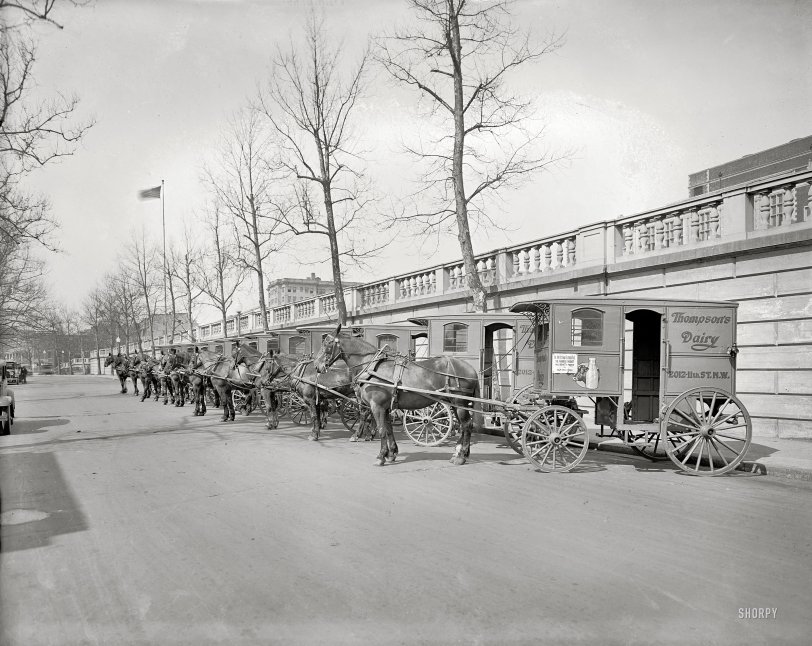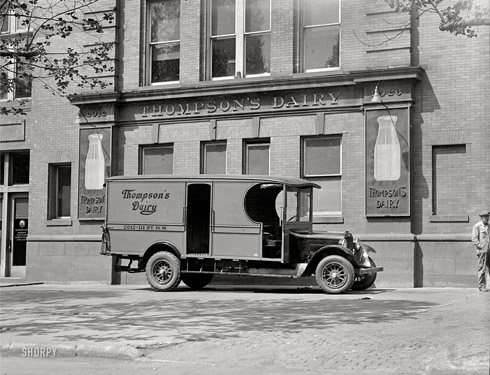


Framed or unframed, desk size to sofa size, printed by us in Arizona and Alabama since 2007. Explore now.
Shorpy is funded by you. Patreon contributors get an ad-free experience.
Learn more.

- Baldwin 62303
- Baldwin VO-1000
- Cold
- No expense spared
- Tough Guys
- Lost in Toyland
- And without gloves
- If I were a blindfolded time traveler
- Smoke Consumer Also Cooks
- Oh that stove!
- Possibly still there?
- What?!?
- $100 Reward
- Freeze Frame
- Texas Flyer wanted
- Just a Year Too Soon
- WWII -- Replacing men with women at the railroad crossing.
- Yes, Icing
- You kids drive me nuts!
- NOT An Easy Job
- I wonder
- Just add window boxes
- Icing Platform?
- Indiana Harbor Belt abides
- Freezing haze
- Corrections (for those who care)
- C&NW at Nelson
- Fallen Flags
- A dangerous job made worse
- Water Stop
Print Emporium
Thompson Dairy: 1927

Washington, D.C., circa 1927. "Thompson Dairy wagons." National Photo Company Collection glass negative. View full size.
Thompson Dairy is delicious
The wall is at the base of Cardozo High School. Thompson's was on route to the pool for us, If a milk man was outside we would beg for milk, sometimes it worked, most of the time not. This was so long ago I hope im remembering right. After all we begged everybody, watermelon man, fruit man, milk man etc. You can no longer put milk in a box outside and expect it to be there when you get back. High Dairy stores also delivered quits a blow to the home milk industry.
Horses were quiet
I remember reading years ago, I forget where, that dairies and ice houses persisted in using horse-drawn vehicles long after most businesses had moved entirely to motorized vehicles, because they made their deliveries early in the morning, and they were afraid of waking someone up with an ill-timed exhaust backfire. They are said to have been early adopters of rubber tires for the same reason, but these wagons appear to have steel tires. There were horse-drawn dairy and ice wagons until World War II, according to some sources.
Milk Horse
Saskatoon is considerably smaller than Washington but the largest dairy here was using horses on some routes as late as 1962 or 1963. Their old horse barns were still standing into the early 1970s. The horses knew their accustomed routes and they worked them on a daily basis. We didn't take milk from that particular company but as a young child I would see a milk horse in the neighborhood on a daily basis.
Nav system
It's true. My grandpa was a milkman in Connecticut during the 20s and 30s -- and used a horse to pull the wagon. At each house he'd take the products off the wagon and deliver to the porch. By that time the horse had already walked up to the next customer's house and they'd repeat. He really missed that part of the system when he bought a truck.
City Park Dairy
In the 1940s, the City Park Dairy in Denver CO delivered milk by horse drawn wagon. I can remember looking out the window of my bedroom and seeing the milkman coming in the back yard from the alley.
Horse Trumps Horsepower
From "City Milk Supply" 1917; Use of Motor Vehicles in Collecting and Delivering Milk
"They (motor vehicles) have been tried for regular house-to-house retail delivery but have usually failed in this field because of the continual starting and stopping, because two men are required for reasonable speedy delivery, and because they cannot move unattended from door to door as the ordinary intelligent horse does, while the driver is delivering bottles."
Horses - semi-autonomus vehicles of the day
Yes - horses do lean the route, and a good one could be trusted to walk and wait as appropriate while the milkman zipped up to the address. They were also quieter during pre-dawn rounds compared to the no muffler trucks of the time. The narrow wagons also were better for use in tight mews-style alleyways, and over the unpaved rights of way behind row houses.
Gone?
If you had asked me, I would have sworn we were still buying Thompson's milk at the store today!
Bat Day
Thompson Dairy sponsored "Bat Day" for kids at D.C. and then renamed RFK Stadium in the 1960's for The Washington Senators Baseball Team. Each baseball season, children 12 years of age and under entering the ballpark on a specified date would receive a wooden baseball bat engraved with The Washington Senators and Thompson Dairy names on the spot where a players name would be engraved on the bat today. I still have one of my bats from those days.
Lasted a long time
In my home city in the Midwest, we still had a horse-drawn milk wagon up until almost 1970. The driver would bail off the wagon with milk for several houses and the horse would keep going until the next stop where he would wait for the driver to catch up to him. Yes - the horses did know their routes.
Skip
The wall today.
The chocolate milk was the best!
It was the best tasting milk ever! And the freshest. They have been gone for a long time now and I still remember the glass bottles.
Mr T must have been old fashioned.
By 1927 most businesses were using motorized transportation.
Mr Thompson, or his son, must have liked the way things were done in 1881, and saw little reason to keep up with the times. I am curious about how much longer they were in business.
[The dairy used both horses and motor trucks. Below, a Thompson delivery van circa 1925. - Dave]
Location
I'm stumped as well, but the building in the background looks like a school, if that helps.
Cardozo
It looks like that is the 1200 block of Florida Avenue NW, looking northwest toward the Cardozo High School football field. You can see the top of the school building in the distance behind the balustrade.
Clever Hans
The horse learns the route and the stops, is one of the advantages.
The driver becomes a passenger most of the time.
Hans, of the "Clever Hans Fallacy," was a milk truck horse.
Re: Location
I'm a bit stumped on the location as well stanton-square. The wall looks a bit like the wall in the Lower Senate Park, but I don't think it is.
Great Wall of Florida
This was taken from Florida Avenue, where that wall still exists. You can still see the same building on the corner in the distance today. Cardozo (Central) HS in the background.
Health in Every Bottle
Anyone know the location? Is that The Cairo in the background?
Washington Post, Feb 18, 1924"Health in Every Bottle"
The most careful handling of our milk from the cow to the consumer guarantees a very wholesome and healthy product. Our Health Department rating has been above 93 for several months.
Guaranteed Quality and ServiceThompson's Dairy
Established 1881
2008-2026 Eleventh Street N.W
Phone North 5996 or 5997A Thompson's Dairy Wagon Passes Your Home
Every Morning Before Breakfast
The supply chain
Cow milk being delivered by horses for consumption by humans. I'm not sure what to think.
Urban Legend
Is it true the horses would remember the routes?
Lost Washington
Lost Washington: Thompson's Dairy.
Horsepower vs horse power
A nice display of horse-power on both sides of the street.
I am actually surprised that a whole company was still using horse-drawn wagons as late as 1927. I would expect it of a lone farmer or single vegetable merchant, but not a commercial concern that could use the investment in new trucks as a tax deduction.
My mother (born in late 1929) tells of a produce salesman who used a horse cart to travel through the streets of Brooklyn shouting "watermelons, 5 cents a pound" and whatever else he had that day. He was still around when I was a child (1960s), still shouting the same songlike advertising chant, but in a very old truck (1946 or 47 vintage) by then.
Wonder when Thompson Dairy went to motorized vehicles, or if they did have some by 1927, and only took the photo of the remaining horses, knowing these were the last horses the company would have.
Where milk came from
When I was little, living in a freshly-minted development west of Laurel, we got milk delivered from Thompson's; you can still see "THOMPSONS DAIRY" painted on the roof of the old King Farm barn on Rockville Pike. By the time my parents and I moved in, the future was already running, right around the corner: the mammoth Md. & Va. Milk Producers plant on Leishear Road.

























On Shorpy:
Today’s Top 5